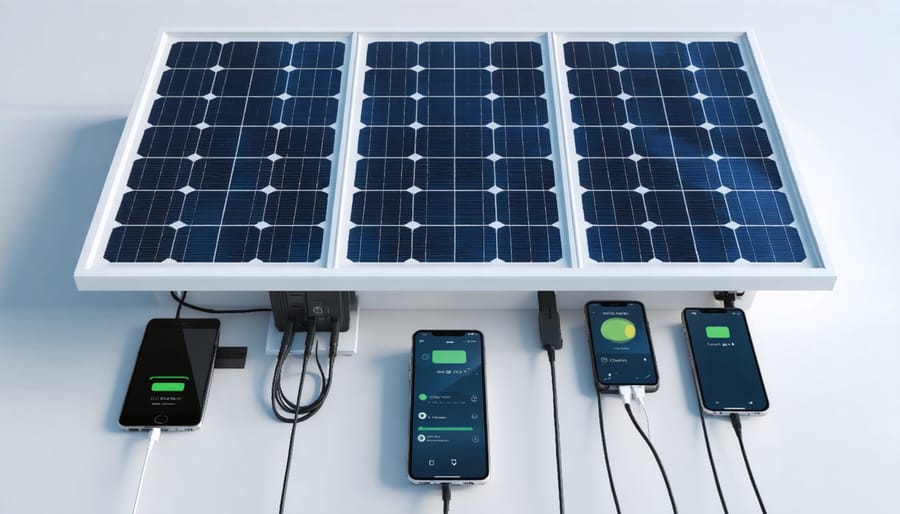Transform your living space into a sustainable sanctuary with eco-friendly home solutions that make a real impact. Install smart thermostats and LED lighting systems to slash energy consumption by up to 30% while maintaining optimal comfort. Replace traditional appliances with ENERGY STAR certified models, reducing both utility bills and carbon footprint. Create a robust recycling station with clearly labeled bins for different materials, and start composting kitchen scraps to reduce household waste by up to 40%.
Switch to low-flow water fixtures and collect rainwater for garden irrigation, potentially saving thousands of gallons annually. Consider solar panel installation or community solar programs to generate clean energy and potentially eliminate electricity bills entirely. These practical modifications not only contribute to environmental preservation but also increase your home’s value and reduce monthly operating costs.
By implementing these sustainable changes, you’ll join millions of homeowners already making a difference through conscious living choices. The best part? Most of these improvements can be completed in a weekend, delivering immediate benefits to both your wallet and the planet.
Energy-Efficient Lighting Solutions
Natural Light Optimization
Maximizing natural light in your home isn’t just about creating a bright, welcoming space – it’s a powerful way to reduce your energy consumption and create a healthier living environment. Start by keeping your windows clean and removing any obstacles that might block sunlight from entering your home. Consider trimming outdoor vegetation that casts excessive shadows on your windows.
Strategic mirror placement can dramatically increase natural light by reflecting it deeper into your rooms. Position mirrors opposite windows or in darker corners to bounce light throughout the space. Light-colored walls and glossy surfaces also help distribute natural light more effectively.
For rooms with limited window access, consider installing skylights or solar tubes. These additions can flood your space with natural light while maintaining privacy. Use light-filtering window treatments instead of heavy curtains – cellular shades or sheer fabrics allow you to control light without blocking it completely.
Arrange your furniture to maximize light flow, keeping taller pieces away from windows. For home offices, position your desk to take advantage of natural light while avoiding screen glare. Remember, by optimizing natural light, you’ll not only reduce your electricity bills but also boost your mood and productivity.

LED and Smart Lighting Systems
Making the switch to sustainable lighting solutions is one of the smartest ways to reduce your home’s energy consumption. LED bulbs are leading the charge in modern lighting technology, using up to 90% less energy than traditional incandescent bulbs while lasting up to 25 times longer.
Smart lighting systems take energy efficiency even further by giving you precise control over your home’s illumination. Install motion sensors in less-frequented areas like hallways and bathrooms, so lights turn off automatically when no one’s around. Use smart plugs or bulbs that connect to your phone, allowing you to create automated schedules and adjust brightness levels remotely.
Consider installing dimmer switches throughout your home – they not only create the perfect ambiance but also help reduce energy usage when full brightness isn’t needed. For outdoor spaces, solar-powered pathway lights and motion-activated security lights combine safety with sustainability. Remember to choose warm white LEDs (2700-3000K) for living spaces to create a cozy atmosphere while maintaining energy efficiency.
Eco-Friendly Furniture and Materials
Sustainable Material Selection
When selecting materials for your home office, choosing sustainable options can make a significant impact on both the environment and your wellbeing. Bamboo stands out as an excellent choice for furniture and accessories, thanks to its rapid growth rate and natural durability. This versatile material works beautifully for desks, shelving, and even decorative elements.
Another eco-friendly option is reclaimed wood, which adds character while preventing further deforestation. Look for furniture pieces made from salvaged timber or give new life to vintage wooden furniture through restoration. Cork is gaining popularity as a sustainable material choice, offering natural sound absorption and antimicrobial properties – perfect for bulletin boards and floor tiles.
For upholstered items, consider furniture featuring organic cotton, hemp, or recycled polyester fabrics. These materials reduce chemical exposure in your workspace while supporting sustainable agriculture. When it comes to decor, opt for items made from recycled glass, natural fibers, or biodegradable materials.
Don’t overlook the importance of finishes and treatments. Choose low-VOC or natural finishes for wooden furniture, and look for water-based adhesives and paints. For metal elements, recycled aluminum and steel are excellent sustainable choices that maintain durability without compromising environmental responsibility.
Remember that sustainable materials often come with certification labels like FSC (Forest Stewardship Council) or GOTS (Global Organic Textile Standard). These certifications help ensure your choices truly support environmental conservation.

Upcycling and Second-Hand Solutions
Breathe new life into your home while reducing environmental impact through smart upcycling and second-hand solutions. Before rushing to buy new furniture or decor, explore creative upcycling ideas that can transform existing pieces into stunning statement items.
Start by reimagining old wooden furniture with eco-friendly paint or natural finishes. That dated dresser could become a charming entertainment center, while vintage suitcases make unique side tables or storage solutions. Got mismatched dining chairs? Unite them with consistent color schemes or fabric choices to create an intentionally eclectic set.
When shopping, prioritize second-hand marketplaces, local thrift stores, and estate sales. These sources often yield high-quality pieces at fraction of the cost of new items. Look for solid wood furniture, which tends to last longer and can be refinished multiple times.
Consider these quick transformation ideas:
– Transform mason jars into light fixtures or organizing solutions
– Convert old ladders into shelving units
– Use vintage doors as headboards or dining tables
– Repurpose wooden crates into modular storage
– Turn wine bottles into vases or candle holders
Remember to properly clean and restore second-hand items using natural cleaning solutions. For upholstered pieces, steam clean thoroughly and use natural fabric refreshers. Your creative touch can turn someone else’s castoffs into your home’s most interesting conversation pieces.
Energy Management Strategies
Smart Power Management
Managing your home’s power consumption smartly isn’t just good for the planet – it’s great for your wallet too. Start by upgrading to smart power strips that automatically cut power to devices when they’re not in use, eliminating those sneaky energy vampires that drain electricity even in standby mode. Installing a smart thermostat can help you optimize energy efficiency by learning your schedule and adjusting temperatures automatically.
Consider switching to LED smart bulbs throughout your home. These can be controlled via your smartphone, allowing you to adjust brightness levels and turn lights off remotely. Many models even integrate with voice assistants for hands-free control. Setting up zones in your home with motion sensors ensures lights only operate when needed.
For larger appliances, look for models with Energy Star certification and smart features that run during off-peak hours. A home energy monitoring system can provide real-time insights into your power usage patterns, helping you identify areas for improvement. Some systems even send alerts when unusual consumption spikes occur.
Don’t forget the basics: use natural light when possible, maintain your HVAC system regularly, and create automated schedules for your smart devices to maximize energy savings while maintaining comfort.
Climate Control Optimization
Maintaining comfortable temperatures in your home doesn’t have to come at the expense of the environment or your utility bills. Start by sealing any drafts around windows and doors with weatherstripping or door sweeps – it’s an easy weekend project that makes a big difference. Installing a smart thermostat can reduce your energy usage by up to 15% by automatically adjusting temperatures based on your daily routines.
Make the most of natural climate control by using your windows strategically. During summer, close blinds during peak heat hours and open windows at night to let in cool air. In winter, do the opposite – let in warming sunlight during the day and close everything up tight at night.
Consider installing ceiling fans in frequently used rooms. They use far less energy than air conditioning and can make a room feel 4-5 degrees cooler. For heating, opt for zonal heating solutions that warm only the spaces you’re using rather than the entire house.
Don’t forget about proper insulation – it’s your home’s temperature control superhero. Check your attic, walls, and crawl spaces to ensure they’re adequately insulated. And remember to regularly maintain your HVAC system – clean filters and annual tune-ups help it run more efficiently while extending its lifespan.
Green Tech Solutions
Energy-Efficient Devices
When selecting office equipment, energy efficiency should be your top priority. Look for devices with ENERGY STAR certification, which typically use 60% less electricity than standard models. Start with your computer – opt for a laptop instead of a desktop when possible, as laptops generally consume less power. If you need a desktop, choose one with power-saving features and an efficient processor.
For printing needs, invest in an inkjet printer rather than a laser printer, as they use significantly less energy. Enable sleep mode on all your devices and use smart power strips to eliminate phantom energy drain when equipment isn’t in use. LED desk lamps and monitors not only reduce energy consumption but also last longer than traditional options.
Consider solar-powered chargers for your mobile devices and wireless peripherals. Many modern keyboards and mice now come with built-in rechargeable batteries or solar panels, eliminating the need for disposable batteries. When upgrading equipment, look for products with high energy efficiency ratings and eco-friendly manufacturing processes.
Remember to properly maintain your devices – clean filters, update software, and optimize settings regularly to ensure they operate at peak efficiency. These small adjustments can lead to significant energy savings over time.
Sustainable Charging Solutions
Powering your devices sustainably doesn’t have to be complicated or expensive. Solar charging solutions have become increasingly accessible, with portable solar chargers and power banks offering convenient ways to keep your devices running on clean energy. Consider investing in a window-mounted solar charger, which can power your smartphones and tablets while making use of natural sunlight.
For a more comprehensive solution, explore solar charging stations that can handle multiple devices simultaneously. These often come with built-in batteries for nighttime charging and cloudy days. USB solar chargers are particularly versatile, working well for both indoor and outdoor use.
Beyond solar, look into wind-up chargers and kinetic energy solutions that convert movement into power. Many of these devices double as emergency backup power sources, making them practical additions to any sustainable home. For desktop setups, smart power strips with USB ports can help manage energy consumption by automatically cutting power to devices when they’re fully charged or not in use.
Remember to position your charging stations near windows or in areas with ample natural light to maximize their efficiency. This simple adjustment can significantly improve their performance while reducing your reliance on grid electricity.

Waste Reduction Strategies
Digital Organization
In today’s digital age, reducing paper waste is easier than ever. Start by setting up a digital filing system using cloud storage services like Google Drive or Dropbox to store and organize your documents. Scan important papers using your smartphone’s camera or a dedicated scanner, and establish a systematic naming convention for easy retrieval.
Consider switching to digital alternatives for traditionally paper-heavy items: opt for e-bills, digital receipts, and online banking statements. Create a designated email folder for important documents and use note-taking apps for meetings and reminders instead of paper notebooks.
To maintain organization, schedule regular digital clean-ups to sort through files and delete unnecessary documents. Back up your digital files regularly to prevent data loss. When printing is unavoidable, use both sides of the paper and consider investing in a printer with eco-friendly features.
By embracing digital solutions, you’ll not only reduce paper waste but also create a more efficient, clutter-free home environment while contributing to forest conservation.
Recycling and Composting
Setting up an effective recycling system in your home is easier than you might think and makes a huge impact on your environmental footprint. Start by designating separate bins for different materials – paper, plastic, glass, and metal. Place these bins in convenient locations where waste typically accumulates, like your kitchen or home office.
Consider creating a mini composting station for food scraps and organic waste. A countertop compost bin in your kitchen makes it easy to collect vegetable peelings, coffee grounds, and eggshells. If you have outdoor space, maintain a larger compost bin in your yard to transform these scraps into nutrient-rich soil for your garden.
Make recycling intuitive by clearly labeling bins and keeping a simple guide nearby for family members or roommates. Break down boxes and crush containers to maximize bin space. Remember to rinse containers before recycling to prevent contamination, and check your local recycling guidelines to ensure you’re following proper sorting procedures.
For items that can’t go in regular recycling bins, create a designated spot for electronics, batteries, and other special materials that require specific disposal methods.
Creating a sustainable home isn’t just about making big changes – it’s about taking small, consistent steps toward a greener lifestyle. Throughout this guide, we’ve explored various ways to make your living space more environmentally friendly, from energy-efficient appliances to water conservation methods and sustainable materials.
Remember that sustainability is a journey, not a destination. Start with the changes that feel most manageable to you, whether that’s installing LED bulbs, setting up a composting system, or creating a small herb garden. As you become comfortable with these initial steps, you can gradually incorporate more sustainable practices into your daily routine.
The benefits of sustainable living extend far beyond environmental impact. You’ll likely notice reduced utility bills, improved indoor air quality, and a more comfortable living space. Plus, many of these changes can increase your home’s value while reducing your carbon footprint.
Don’t feel pressured to implement everything at once. Choose a few ideas that resonate with you and your lifestyle, and build from there. Every small change matters, and your efforts contribute to a larger global movement toward sustainability.
We encourage you to share your sustainable living journey with others, as your experience might inspire friends and family to make their own eco-friendly changes. Together, we can create more sustainable communities, one home at a time.
